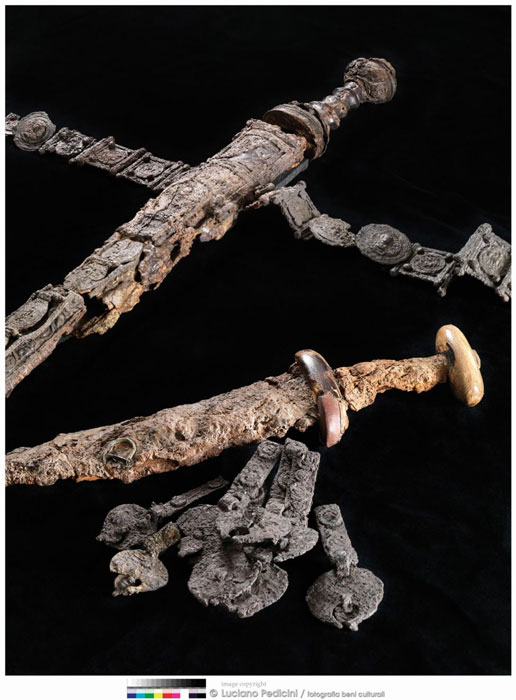
Volcano-blasted Herculaneum Roman Soldier Tells His Ancient Secrets
Archaeologists in Italy are studying the remains of a Roman soldier who was thrust face-first into the sand at Herculaneum when Mount Vesuvius erupted on October 24th 79 AD. The presence of this particular Roman soldier suggests hundreds of ancient Romans fleeing the eruption of Vesuvius were only minutes away from being rescued on a boat, but they all perished. Who was this man, and why do archaeologists hold him as being more important than the hundreds of other bodies discovered on hell’s own beach in ancient Herculaneum so long ago?
Wandering In The Footsteps of An Elite Roman Soldier
Herculaneum is a protected UNESCO beach that was buried along with Pompeii during the eruption of Mount Vesuvius on October 24th 79 AD. Archaeological work at this site began 40 years ago when the remains of 300 people were found on the beach.
Late last year I wrote about a current archaeological project that aims to restore Herculaneum. Once the planned works are complete visitors will be able to stroll along the sands in the footsteps of the elite Romans who all perished in the lethal forces of nature that flattened the entire region in 79 AD.

Eruption of Mount Vesuvius in 1631 near Naples, Italy from an ancient 17th-century painting by Giovanni Battista Passeri. (scaliger / Adobe Stock)
One of the most perplexing questions about the Mount Vesuvius explosion is why so many people lived on the side of a sleeping geological monster? Well, like today, in the ancient world people were bonded to their ancestral territories and for thousands of years the slopes of the volcano had been farmed.
- Hiding From Mount Vesuvius Prolonged Victims' Deaths
- Secrets in 2,000-Year-Old Scorched Scrolls of Herculaneum to be Revealed with New Tech
Nobody at that time would have associated the increasing tremors and smoking mountain peak as a sign of impending disaster, so, everyone in the region was taken by surprise and for the most part vaporized soon after the volcano erupted.

A bag with tools, on the Roman soldier’s back below his skull, was also found with the skeleton of the Roman soldier. (Parco Archeologico Di Ercolano)
Reinterpreting The Beached Old Roman Soldier
In BBC2's 2013 documentary The Other Pompeii: Life and Death in Herculaneum, presenter Wallace-Hadrill told the story of the tragic event of 79 AD. “We all make the mistake of seeing ancient Roman society as comprising of only rich and poor people,” said Hadrill, but “Herculaneum gives us back the middle people – and they are extraordinary,” said the presenter.
Now, Francesco Sirano, Herculaneum Archaeological (Parco Archeologico Di Ercolano) Park Director, has told reporters at ANSA that one of the 79 AD victims that was unearthed during the first excavation at Herculaneum and identified as a soldier, “may have had a much more important role.”
After the pyroclastic surges swept down the crumbling sides of Mount Vesuvius engulfing farmhouses, animals and people, a surge of gritty hot air blasted the luxury resort of Herculaneum at around 80-100 kilometers per hour (50-62 miles per hour). This pushed many people into the sea and hundreds of Herculaneum residents took temporary refuge inside storage containers ( fornixes), which were normally used for stowing nets and fishing equipment on the beach.

The sword, dagger and belt found next to the Roman soldier of Herculaneum. (Luciano Pedicini / Parco Archeologico Di Ercolano)
Putting New Clothes On Old Roman Soldier Bones
Returning to our story, Sirano explained that the man discovered during the first excavation of the beach “might have been a navy officer of the legendary rescue fleet launched by Pliny the Elder in the Bay of Naples after the explosion.”
A bone analysis of the Roman soldier determined he was aged between 40 and 45 and that he was healthy and used to physical activity.
- The Illustrious Life of Pliny the Elder, Ancient Historian and Roman Commander
- Deadly Volcanoes: The Eruptions that Reshaped the World and Became Legends
Archaeologists at Herculaneum have been fortunate enough to have discovered organic materials, and the man’s skeleton was found with fragments of armor and a rectangular shoulder bag that contained a collection of small handheld carpentry tools.
Furthermore, the soldier/sailor wore a precious dagger and a leather belt with silver and gold plates from which a sword hung, with a finely designed ivory hilt.
Beside the man, buried in sand, the researchers discovered “12 silver and two gold denarii” which equates to the monthly wages of a Pretorian Guard, according to site Director Francesco Sirano.
While Sirano is convinced the man was part of the rescue fleet sent out after the explosion he adds that it might have been the case that he was a different type of soldier.
So, the next phase of restoration work will focus on the recovered weapons of the Herculaneum beach soldier, and this is hoped to determine his rank and file once and for all.
Top image: The discovery of the Roman soldier’s skeleton on the beach at Herculaneum 40 years ago and an Italian archaeologist. Source: Parco Archeologico Di Ercolano
By Ashley Cowie
















Comments
Don’t even think about watching the video clip, it is just too exciting.